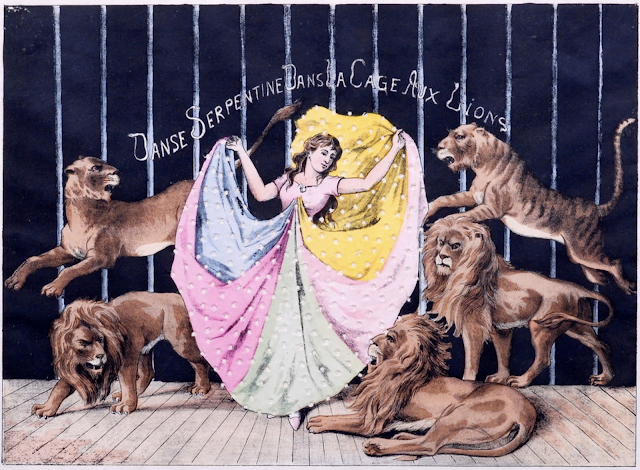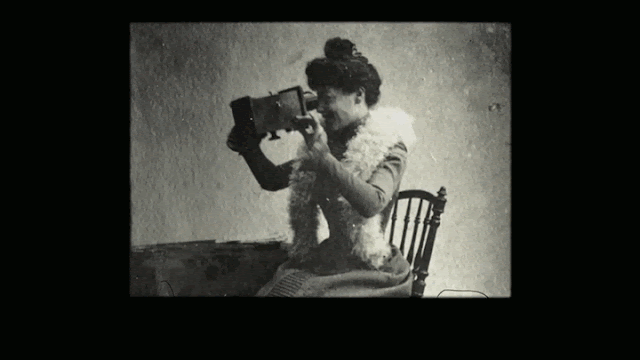Alice Guy-Blache, la Ire
femme metteur en scene.
— Vous êtes bien jeune,
mademoiselle, pour occuper un
poste aussi important.
— Ne craignez rien, monsieur, cela me passera !
Telle fut la repartie que
M. Leon Gaumont, alors fonde
de pouvoirs du Comptoir General de Photographie, recevait
a
bout portant un beau jour
de 1894. Son interlocutrice
etait une
frele jeune fille de
dix-neuf ans, au
regard decide,
qui briguait la place de secretaire du patron. Elle s'appelait
Alice Guy. Elle fut engagee.
Deux ans plus tard, Gaumont, ayant rachete le Comptoir, s'interesse au
cinematographe naissant. Les freres
Lumiere l'ont invite en mars
1895, ainsi que sa
bouillante
petite secretaire, a
la fameuse
seance
de la Société de Photographie ou
ils presentent
le
premier film
: « La sortie des
Usines Lumiere ». Gaumont
a
depuis construit ses propres
appareils. Ses operateurs et
ceux
des Lumiere (qui arreteront leur exploitation en
1898) mitraillent a
la ronde les
scenes
de la rue :
arrivees de
trains, defiles militaires, etc...
Le premier emerveillement
passe,
cela devient monotone.
La petite
Alice Guy, qui a
l'esprit vif, declare a son
patron :
— II faudrait tourner des
petits sketches, avec costumes,
mise en scene, etc...
— Bonne idee, repond
Gaumont. Occupez-vous en
donc. Ce cinematographe est
tout a
fait du travail pour
jeune
fille !
Alice Guy avise une plateforme goudronnee a
ciel ouvert
en bordure des ateliers Gaumont, mobilise les services d'un
peintre en eventails qui habite
dans le voisinage, ecrit un
scenario, trouve des acteurs
benevoles, s'adjoint un operateur, plante un decor en
carton découpé et peint. Et en
route ! Voila le premier film
a
scenario tourne aux ateliers
Gaumont:
«
La fee aux choux ».
II a 30 metres et la pellicule
60 mm. de large. Nous sommes
en 1896. La Française Alice
Guy vient de prendre date
pour se classer premiere femme
metteur en scene du monde.
Interrogee sur son titre,
bien des annees apres, par le
fils, de son ancien patron,
M. Louis Gaumont, elle lui
ecrit
:
«
...
Je pense que les
Lumiere, avec L'arroseur arrose,
sont les premiers metteurs en
scene ;
je ne revendique que
le titre de premiere femme
metteur en scene, auquel je
fus seule, pendant 17 ans, a
avoir droit ».
Pendant les annees qui
suivent La fee aux choux
Alice Guy met en scene pour
la maison Gaumont plus de
cent films. De ceux-ci il ne
reste malheureusement que les
titres des catalogues, des photos
et quelques fragments, dont
ceux d'une Passion qui fut en
France l'ceuvre la plus importante et la plus grave d'Alice
Guy et que l'on vient de retrouver en Allemagne.
II est probable que l'interet que suscitent dans le
public, enfin averti, l'étonnante carriere et la personnalite d'Alice Guy, va contribuer a
faire sortir ses films de
leurs poudreuses cachettes.
Alice Guy, metteur en scene
chez Gaumont, voyait ses films
inscrits au catalogue de la
maison. Ils n'etaient que rarement presentes au public sous
son nom, exception faite de
cette Passion, film de 800
metres, avec 21 decors et une
vaste figuration, dont elle possede encore toutes les photos.
Devenue prematurement
veuve en 1922, elle rentra en
France apres avoir liquide son
studio de New-Jersey, mais
le monde du cinema se montra
peu enclin a
faire place a cette
revenante. Brisee par la perte
de son mari et le bouleversement de sa vie, Alice Guy ne pensa plus qu'a
elever ses enfants. En femme
de devoir simple et courageuse,
elle rentra dans l'obscurité que
tout le monde semblait si bien
s'accorder a
lui laisser en
partage.
Elle en sort aujourd'hui avec
un peu d'etonnement. Charmante vieille dame qui a garde
toute sa vivacite d'esprit, elle
habite un sixieme ensoleille
non loin de l'Opera. La Cinematheque Française a
fete recemment ses 85 printemps.
Au cours de la reception donnee
en son honneur, M. Louis
Gaumont a pris la parole pour
dire ce que fut son ceuvre. Elle
n'a pas aujourd'hui de plus
zélé champion que le fils de son
ancien patron.
Demandez un jour dans
un club de cinema de quand
date le premier film parlant.
Alice Guy-Blache peut vous repondre, car c'est elle qui l'a
tourne en 1902. Cela s'appelait
dans ce temps-la des
«
phonoscenes » : on enregistraitd'abord
la voix sur rouleau de cire,
puis le phonographe etant synchronise avec la camera, on
procedait a
l'adaptation des
gestes sur les paroles :
procédé
inverse de celui du doublage
actuel. II existe une magnifique photo a
contre-jour montrant, au fond, sur une scene
eclairee par des projecteurs a
arc, la cantatrice Rose Caron
jouant une scene de Mignon,
tandis qu'on distingue en
ombre chinoise 1'immense
pavillon d'un phonographe a
rouleau et une camera entre
lesquels se dresse, toute mince,
l'intrépide petite silhouette
d'Alice Guy, reglant la mise
en scene.
— Ah ! nous dit Alice
Guy-Blache en nous montrant
sa collection unique de photographies, les artistes de ce temps-la avaient la fierte de
la conscience professionnelle !
Un jour, Rose Caron, pendant
qu'elle jouait une scene de
Mignon deja enregistree, posait
le pied sur un charbon incandescent qui avait saute d'une
lampe a arc. Souffrant horriblement, elle joua la scene jusqu'a la fin et s'evanouit. Si
je m'en etais aper<,:ue, j'aurais
fait interromprej^la prise de
vues, mais elle n'avait pas
voulu,
« pour si peu », dit-elle,
nous faire recommencer le
travail.
Alice Guy a mis en scene
et dirige, tantot seule, tantot
avec des assistants qu'elle choisissait elle-meme, une centaine
de ces «
chronophones » parmi lesquels plusieurs operacomiques et operettes, et des
chanteurs comiques comme
Mayol, Dranem, Polin.
Le comique faisait prime
a
l'epoque dans ces courtes
bandes que Pathe et Gaumont
produisaient a
la douzaine et
les artistes «
serieux )) y regardaient a
deux fois avant de se
commettre avec
la nouvelle
invention. Caruso, pressenti,
accepta, puis se
ravisa. C'etait
le temps ou le cinema connaissait de beaux jours dans
les baraques foraines et Alice
Guy-Blaché, dont les films
comiques etaient fort apprecies,
a
la-dessus de bien pittoresques
souvenirs qu'elle racontera,
nous
l'espérons, dans les memoires qu'elle est en train
d'ecrire et dont un editeur
avise ne
tardera certainement
pas a
s'emparer.
Loin de se
terminer avec
son mariage en 1907,
la carriere
d'Alice Guy devenue Mme
Blache, prenait un nouvel essor.
Son mari ayant ete nomme
agent de la maison Gaumont
aux Etats-Unis, qu'allait faire
cette dynamique petite femme
de son temps et de ses
energies
disponibles ? C'est bien simple :
elle fit construire son propre
studio a Fort Lee, dans le
New-Jersey, non loin de NewYork, et se mit a tourner des
films. Scenariste et metteur en
scene, et de plus proprietaire
de la firme Solax Co qu'elle a
fondee, elle realise jusqu'en
1918 environ deux cents films
dont un
grand nombre de
titres nous ont ete conserves.
Elle y
dirige les vedettes de
l'epoque : Bessie Love, Julia
Moore, Dolores Costello, Nazimova, Olga Petrova, Ethel
Barrymore, Tom Mix. Son
mari, a
la fin de son contrat
avec Gaumont, vient se
joindre
a
elle. Alice Guy-Blache est
bien connue a cette epoque
dans tout
le monde du cinema
americain
:
elle est en relations
amicales avec Griffith. Elle
lutte dur au milieu des intrigues
et des embuches qui commencent a se dresser sous
les
pas
des pionniers avec
la
naissance des grandes compagnies. Pendant dix-huit mois
la Metro a vecu
de la production de la Solax. Ses autres
films etaient distribues par
la First Nation, aujourd'hui
reprise par Warner, la World
Pathe, etc...
Puis vient l'intrusion des
grandes combinaisons financieres dans l'industrie du
cinema, le commencement de
1'exode vers
la Californie et
la naissance d'Hollywood,
la
mort d'Herbert Blache... La
courageuse petite veuve se
sent trop desarmee :
elle abandonne la partie, elle rentre en
France, en France ou elle a
tant
fait pour
le cinema et ou
on ne veut plus d'elle... Et
tombe le rideau de l'oubli
tandis que
disparait définitivement pour
le cinema «
l'age
de l'innocence ».
She Invented the Movies
 Early, forgotten screen comic Fraunie Fraunholz stars in this surviving one-reel farce about a man who loses his shirt on the stock market, and ashamed, resolves to break up with his rich girlfriend (Marian Swayne). She, however, concocts a scheme whereby Fraunie will "inherit" a fortune if he marries before noon. After desperately proposing to every woman who crosses his path -- including an old maid who faints dead away and a married woman -- Fraunie decides to end it all by throwing himself in front of a coming automobile. Said vehicle, however, is carrying not only Marian but also a minister, and the lovebirds are wed right then and there. Fraunie gets a fit when he discovers that Marian has tricked him, but their union is soon sealed with a kiss.
Early, forgotten screen comic Fraunie Fraunholz stars in this surviving one-reel farce about a man who loses his shirt on the stock market, and ashamed, resolves to break up with his rich girlfriend (Marian Swayne). She, however, concocts a scheme whereby Fraunie will "inherit" a fortune if he marries before noon. After desperately proposing to every woman who crosses his path -- including an old maid who faints dead away and a married woman -- Fraunie decides to end it all by throwing himself in front of a coming automobile. Said vehicle, however, is carrying not only Marian but also a minister, and the lovebirds are wed right then and there. Fraunie gets a fit when he discovers that Marian has tricked him, but their union is soon sealed with a kiss.
 Early, forgotten screen comic Fraunie Fraunholz stars in this surviving one-reel farce about a man who loses his shirt on the stock market, and ashamed, resolves to break up with his rich girlfriend (Marian Swayne). She, however, concocts a scheme whereby Fraunie will "inherit" a fortune if he marries before noon. After desperately proposing to every woman who crosses his path -- including an old maid who faints dead away and a married woman -- Fraunie decides to end it all by throwing himself in front of a coming automobile. Said vehicle, however, is carrying not only Marian but also a minister, and the lovebirds are wed right then and there. Fraunie gets a fit when he discovers that Marian has tricked him, but their union is soon sealed with a kiss.
Early, forgotten screen comic Fraunie Fraunholz stars in this surviving one-reel farce about a man who loses his shirt on the stock market, and ashamed, resolves to break up with his rich girlfriend (Marian Swayne). She, however, concocts a scheme whereby Fraunie will "inherit" a fortune if he marries before noon. After desperately proposing to every woman who crosses his path -- including an old maid who faints dead away and a married woman -- Fraunie decides to end it all by throwing himself in front of a coming automobile. Said vehicle, however, is carrying not only Marian but also a minister, and the lovebirds are wed right then and there. Fraunie gets a fit when he discovers that Marian has tricked him, but their union is soon sealed with a kiss.



































